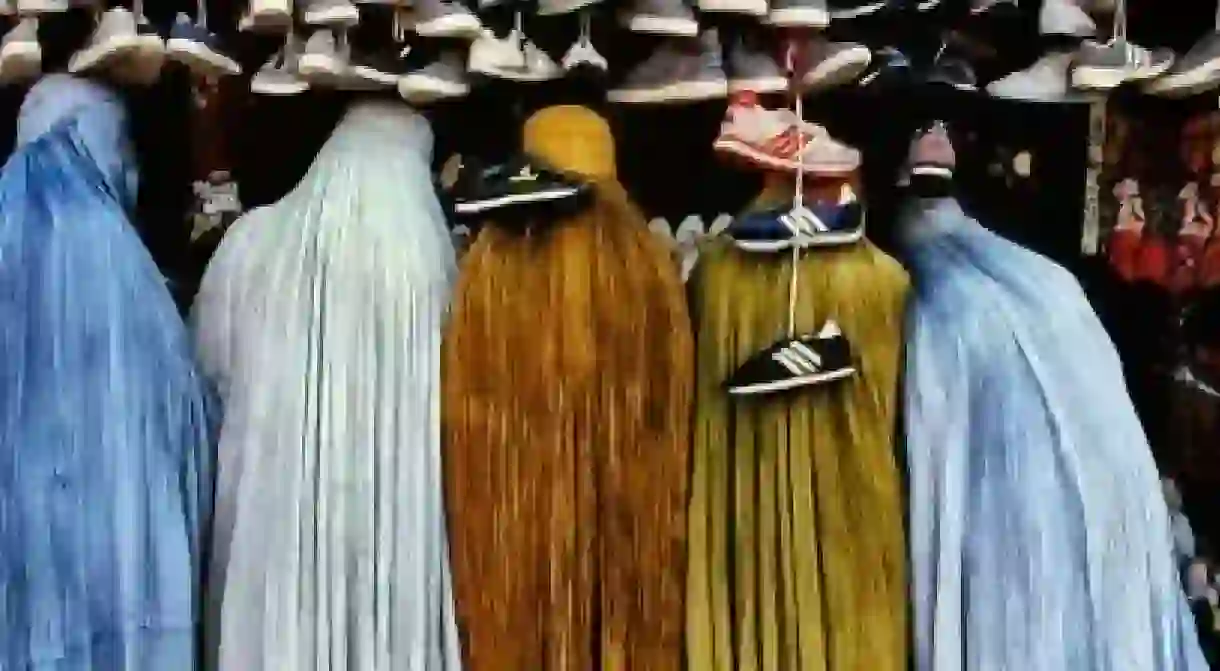Afghanistan Through a Lens: Photojournalist Steve McCurry in London

War and instability have long been associated with Afghanistan. For over three decades the country has been embroiled in conflict, bruising its international image and overshadowing the beauty of its land, people and culture. However, award-winning photojournalist Steve McCurry, whose work is on show in London, explores Afghanistan’s rich heritage through documentary images of Afghanistan’s journey from 1979 to 2006. We look at MCCurry’s work in this indomitable country.

Upon entering the Beetles and Huxley Gallery just off of Piccadilly, it is the monochrome images to the left that initially grab one’s attention. The Mujahideen Fighters Watch Convoy (1979) captures the intensity of the silence that falls before battle. This is the very image, published in The New York Times in 1979, that sparked Steve McCurry’s career, identifying him as a photographer with inside knowledge of the escalating conflict between the Soviet Union and Afghan Nationals.

Yet as you delve deeper into the exhibition Steve McCurry Afghanistan, the images of everyday situations quickly fall into incongruous harmony with the bleak reality of war. Though the theme of war is hardly peripheral in this exhibition, it nevertheless attests to the power of McCurry’s works to magnify human emotion in the face of brutality.


McCurry’s closeness to Afghans and the relationship he developed with the country is particularly evident through his portraiture. McCurry himself says, ‘the one thing I want people to take away from my work is the human connection between all of us.’ One piece which certainly achieves this, and commands centre stage of the exhibition is The Afghan Girl (1984). After the photo was published on the front cover of National Geographic magazine in 1985, Sharbat Gula and her infamous gaze became McCurry’s most recognisable work. Though The Afghan Girl became an international symbol of Afghanistan’s turmoil, a similar tone of anguish resonates in An Afghan Refugee in Baluchistan (1981). By living with civilians during his travels, such close proximity enabled McCurry to capture intimate moments such as Father and Son in Helmand Province (1980). The melancholy seared into the fathers eyes and the sadness of the young boy prompts an empathetic response from the onlooker.


Steve McCurry’s collection also focuses on capturing everyday life in Afghanistan, such as visits to the mosque, prayer, shopping in the market and working life. Through these particular images the nation’s rich cultural heritage, stunning architecture and citizens shine through the sombre backdrop of war with a striking colour palette. The hazy vivid orange of the evening sun in Kuchi Nomads at Prayer (1992) is mesmerising and intensifies the shadowy figures in the foreground, who are performing the evening prayer. Woman in a Canary Burqa (2002) also stands out for its incandescence with the vibrant yellow of the burqa-clad woman perched on a Persian rug against the contrasting violet background, evoking a sense of elegance and majesty. Under the rule of the Taliban the presence of different coloured burqas other than the traditional shade of blue was an unfamiliar sight. McCurry manages to document such rarity in Afghan Women at Shoe Store (1992), in which all five women wear a different coloured burqa whilst shopping for sports trainers.



One of Afghanistan’s architectural gems, the Blue Mosque of Mazar-E-Sharif, serves as a radiant backdrop in photographs such as Salat at Blue Mosque in Mazar-E-Sharif (1992), which encapsulates the beauty of everyday situations. Whilst the lighting in the aforementioned piece illuminates the kaleidoscopic artistry of the mosaic adorned mosque, it is the white doves in Blue Mosque, Mazar-E-Sharif that transform the ordinary into something memorable. The white doves are a tourist attraction at the Blue Mosque, which is why the couple are crouched down to feed the crowd of doves; but it is the way in which the doves in flight frame the couple that evokes the quixotic nature of the everyday ritual of visiting the mosque. The infamous doves instil a similar effect in Pigeon Feeding near Blue Mosque (1991), where a burqa-clad woman is immersed in the sea of doves, with some hovering above her producing an uplifting image.


McCurry’s landscape images boast Afghanistan’s pastoral beauty, in which the country’s imposing mountainous region soars and its sun-baked land fans out freely, unscathed by war. Anguish and brutality are entirely absent in Horse and Two Towers at Band-E-Amir (2002) in which the wild horse evokes a sense of freedom, and the hazy atmosphere engulfing the unperturbed lake and rocky enclave instils a dream-like serenity. Similarly in Farmer Walks through Fields (2006) war appears to be a distant memory, especially when with images such as Men Shovel Debris in Kabul (1993) and Kandahar Bazaar (1992). Though the latter two images reveal the tragedy of destruction and loss of original infrastructure, the subtle form of ancient sculpture embedded in the tired rocky landscape is a nod to an ancient heritage that has dodged demolition.


Journeying through this exhibition is a difficult yet necessary voyage to dismantle our general perception of Afghanistan as a war-torn fundamentalist nation. McCurry’s photography does not by any means sweeten the bleak reality of war, but he strives to document a nation and its people who have long struggled against the daily horror of the most volatile conflict. With his acute observational skills, McCurry’s photography manages to encourage understanding and compassion by bringing us face to face with the hardships of the Afghan people. Though vivid images such as Dead Afghan Soldier (1992) hardly refrain from revealing the horror of human loss, there are many awe-inspiring photos that soar beyond such horrific realities of war. There is also a ray of hope that peeks through, as does the beam of light that illuminates the fondness and slight amusement in the farmer’s eyes in Farmer in Jalalabad (1992); this is the resilience of Afghanistan and its people, fervently enshrined in Steve McCurry’s photography.















